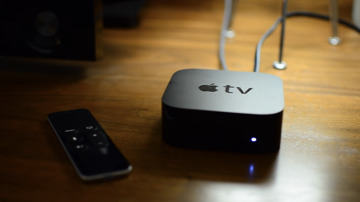The Apple TV+ film "Greyhound" required some lateral thinking from its sound team, with a profile on how the audio mix during a key battle scene revealing the lengths the production went to make it dramatic.
Apple's acquisition of the Tom Hanks naval drama "Greyhound" for the Apple TV+ streaming service was well received by users and critics, with the film depicting the drama of the high-stakes mission. A large part of this was due to its audio mixing, which was a challenge for all involved.
In a profile of rerecording mixer Michael Minkler, supervising sound editor Warren Shaw and sound mixer David Wyman by Variety, the team revealed what went into putting the audience in the middle of the action.
During the third-act climactic scene featuring an attempt by USS Greyhound to avoid torpedoes, Minkler brings up the different elements at play, beyond dramatic music and dialog. "There are sound effects with the engines, the high seas, the explosions coming from both sides," said Minkler.
The audience has to "hear where it ramps up the speed and pulls down," Minkler said of the ship's noises. Sounds of torpedoes were hyper-dramatic, with their movements in the water meant to be heard to give the idea of the warheads heading to the boat.
As research, Minkler and Shaw visited the USS Kidd in Louisiana and talked to veterans about how a captain's orders are given and repeated throughout a crew. This was to get a better understanding of how communications worked in that sort of situation, to increase accuracy.
To give the actors an immersive experience, and to get around not being able to use a boom operator, microphones were placed throughout the ship to capture sound and dialog. "We had a lot of microphones in plain sight, and they were painted the same color as the inside of the ship," explained Shaw.
Playback speakers were also located throughout the vessel, to help the actors "feel the urgency and danger."
"Greyhound" is considered a successful purchase for Apple, as awards season continues. The film has already picked up two nominations for Special Visual Effects and Sound for the British Academy Film Awards, following previous nominations from the Visual Effects Society Awards and the Motion Picture Sound Editors.
The initial release did suffer from sound problems, with an audio-sync issue discovered roughly an hour into the movie in July 2020.
Stay on top of all Apple news right from your HomePod. Say, "Hey, Siri, play AppleInsider," and you'll get latest AppleInsider Podcast. Or ask your HomePod mini for "AppleInsider Daily" instead and you'll hear a fast update direct from our news team. And, if you're interested in Apple-centric home automation, say "Hey, Siri, play HomeKit Insider," and you'll be listening to our newest specialized podcast in moments.
 Malcolm Owen
Malcolm Owen







-m.jpg)






 Charles Martin
Charles Martin
 Wesley Hilliard
Wesley Hilliard
 Stephen Silver
Stephen Silver
 William Gallagher
William Gallagher

 Marko Zivkovic
Marko Zivkovic
 Andrew Orr
Andrew Orr
 Amber Neely
Amber Neely









12 Comments
I turned it off after 20 minutes. The whole “movie” seemed to be nothing more than a bunch of screaming and an endless aural assault. Making me jump out of my chair every two minutes and constantly having to turn the volume down, then back up, then back down, then up, then down, up, down, up, down (even with compression enabled) is not my idea of fun.
This movie was my first experience with the spatial audio on my AirPods Pro, and to this day it’s still the best experience I’ve had with it. Although “Calls” comes pretty close.
Enjoyed the movie very much. I never even thought about or noticed any sound issues. The movie was very well done.
I enjoyed every moment of the film. Watching on a big screen in a darkened room with good speakers helped me experience all the terror, claustrophobia and tension being at sea, under-defended and under constant sneak attack must have entailed. Sound was excellent, and immersive. I never adjusted the volume once the film was underway--no idea why you would want to or have to do that. A real winner in every way.